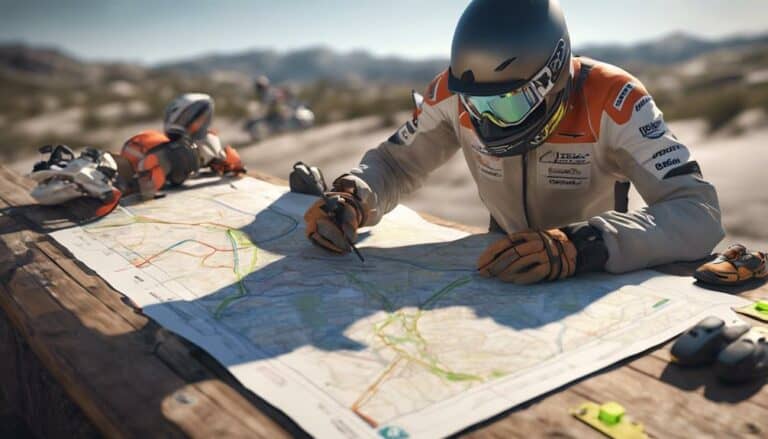Before diving into the adrenaline-fueled world of enduro racing, you must grasp the crucial rules and regulations governing this intense sport. Understanding the nuances of race categories, safety requirements, and etiquette is key to exploring the exhilarating challenges ahead.
By familiarizing yourself with these foundational principles, you'll be well-prepared to commence on your thrilling enduro racing journey.
Key Takeaways
- Familiarize yourself with race categories to choose the right division based on skill level.
- Prioritize safety gear like full-face helmets, knee pads, and hydration packs for protection.
- Practice race etiquette by signaling before passing, respecting others, and communicating effectively.
- Adhere to timekeeping at checkpoints for fair competition, ensuring equal opportunities for all participants.
Race Categories and Classifications
What're the key factors that determine the race categories and classifications in enduro racing for beginners?
Understanding the race categories is important for novice riders entering the world of enduro racing. These categories are designed to cater to different skill levels, age groups, and experience levels, ensuring a fair and competitive environment for all participants.
Divided into divisions such as open men, open women, masters, and juniors, each category has its own set of rules and requirements to maintain inclusivity while challenging riders to progress in their racing journey.
For beginners, selecting the right race category is essential to measure their performance accurately against similar riders and set achievable goals for improvement. By familiarizing yourself with the race classifications and their nuances, you can make informed decisions about which events to enter, how to meet the requirements, and ultimately advance in the exciting world of enduro racing.
Safety Gear and Equipment Requirements
Moving on from understanding race categories in enduro racing, ensuring your safety and meeting equipment requirements is paramount for a successful and secure racing experience.
When gearing up for mountain biking enduro races, there are mandatory rules and safety equipment you must adhere to as a beginner:
- Full-face helmets: In some locations, these may be mandatory to guarantee maximum protection during the race.
- Protective gear: Knee pads and elbow pads are essential for preventing injuries on challenging terrains.
- Hydration pack: Carrying one is recommended to maintain hydration and have essential items easily accessible during the race.
- Eyewear: Goggles or glasses protect your eyes from debris and improve visibility on the trail.
- Safety attire: Wearing long sleeves and appropriate shoes can enhance both safety and performance while enduro racing.
Race Etiquette and Respect for Others
When participating in enduro races, prioritize race etiquette and demonstrate respect towards your fellow riders to verify a smooth and enjoyable experience on the trail.
Proper communication is key – remember to signal with 'Rider' before passing to alert others of your presence. Choose safe spots for overtaking and communicate your intention clearly to avoid surprises. Be prepared for unexpected reactions from other riders and always yield to faster racers when necessary.
Respect the race objectives of others and avoid blocking faster riders during the race. Effective communication and mutual respect are essential for maintaining a positive race environment. By following these guidelines, beginners can contribute to a safer and more enjoyable enduro racing experience for all participants.
Timekeeping and Checkpoints Protocol
Shifting from ensuring race etiquette to maintaining precise timekeeping, mastering the checkpoints protocol is fundamental for maneuvering enduro races successfully. Timekeeping in enduro races isn't just about speed; it's about strategy and precision.
Here are five key points regarding the checkpoint protocol:
- Riders must reach specific checkpoints within designated timeframes during timed stages.
- Penalties may be incurred for arriving at checkpoints too early or too late.
- Understanding the checkpoint protocol is critical for accurate results and fair competition.
- Timekeeping ensures that the race is conducted smoothly and fairly.
- Adhering to the protocol guarantees that all participants have an equal chance to showcase their skills.
Bike Maintenance and Inspection Guidelines
Regularly maintaining your bike is important to guarantee peak performance and safety during enduro races. Before hitting the trails, conduct a thorough bike inspection. Check tire pressure to ensure ideal traction and stability.
Verify brake functionality for quick and precise stops when exploring challenging terrains. Proper chain lubrication is essential to prevent premature wear and maintain smooth gear shifting. Adjust suspension settings according to the trail conditions to enhance control and comfort during the race.
Keep an eye out for wear and tear on components like brake pads, chains, cassettes, and tires. Replace any worn-out parts promptly to avoid performance issues during races. Additionally, maintain a clean bike to prevent debris build-up, which can lead to mechanical problems.
Periodically seek professional servicing to address any underlying issues and make sure your bike is in top condition for enduro racing. By adhering to these bike maintenance guidelines, you can ride confidently and enjoy the adrenaline-pumping experience of enduro racing.
Conclusion
Now that you understand the important rules and regulations for enduro racing, remember to always prioritize safety and respect for others on the track.
For example, imagine feeling the exhilaration of crossing the finish line after overcoming challenging terrain and obstacles, knowing that you followed all the rules and gave it your all.
Stay focused, stay prepared, and enjoy the thrill of enduro racing!

